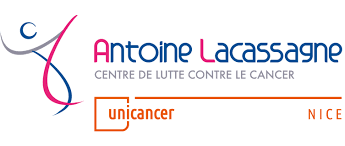PEC-PRO: A new prognostic score from a series of 87 patients with localized perivascular epithelioid cell neoplasms (PEComas) treated with curative intent
Résumé
Background: Perivascular epithelioid cell neoplasms (PEComas) encompass a heterogeneous family of mesenchymal tumors. Previously described clinicopathologic features aimed at distinguishing benign from malignant variants but lacked prognostic value.
Methods: This retrospective analysis examined clinicopathologic data from patients who had localized PEComa across French Sarcoma Network centers. The authors analyzed 12 clinicopathologic features in a Cox proportional hazard framework to derive a multivariate prognostic risk model for event-free survival (EFS). They built the PEComa prognostic score (PEC-PRO), in which scores ranged from 0 to 5, based on the coefficients of the multivariate model. Three groups were identified: low risk (score = 0), intermediate risk (score = 1), and high risk (score ≥ 2).
Results: Analyzing 87 patients who had a median 46-month follow-up (interquartile range, 20-74 months), the median EFS was 96.5 months (95% confidence interval [CI], 47.1 months to not applicable), with 2-year and 5-year EFS rates of 64.7% and 58%, respectively. The median overall survival was unreached, with 2-year and 5-year overall survival rates of 82.3% and 69.3%, respectively. The simplified Folpe classification did not correlate with EFS. Multivariate analysis identified three factors affecting EFS: positive surgical margins (hazard ratio [HR], 5.17; 95% CI, 1.65-16.24; p = .008), necrosis (HR, 3.94; 95% CI, 1.16-13.43; p = .030), and male sex (HR, 3.13; 95% CI, 1.19-8.27; p = 0.023). Four variables were retained in the prognostic model. Patients with low-risk PEC-PRO scores had a 2-year EFS rate of 93.7% (95% CI, 83.8%-100.0%), those with intermediate-risk PEC-PRO scores had a 2-year EFS rate of 67.4% (95% CI, 53.9%-80.9%), and those with high-risk PEC-PRO scores had a 2-year EFS rate of 2.3% (95% CI, 0.0%-18.3%).
Conclusions: The PEC-PRO score reliably predicts the risk of postoperative recurrence in patients with localized PEComa. It has the potential to improve follow-up strategies but requires validation in a prospective trial.
Fichier principal
 Cancer - 2024 - Gantzer - PEC‐PRO A new prognostic score from a series of 87 patients with localized perivascular.pdf (614.96 Ko)
Télécharger le fichier
cncr35277-sup-0001-suppl-data.pdf (4.39 Ko)
Télécharger le fichier
cncr35277-sup-0002-fig_s1.pdf (2.5 Ko)
Télécharger le fichier
cncr35277-sup-0003-fig_s2.tiff (1.46 Mo)
Télécharger le fichier
Cancer - 2024 - Gantzer - PEC‐PRO A new prognostic score from a series of 87 patients with localized perivascular.pdf (614.96 Ko)
Télécharger le fichier
cncr35277-sup-0001-suppl-data.pdf (4.39 Ko)
Télécharger le fichier
cncr35277-sup-0002-fig_s1.pdf (2.5 Ko)
Télécharger le fichier
cncr35277-sup-0003-fig_s2.tiff (1.46 Mo)
Télécharger le fichier
| Origine | Publication financée par une institution |
|---|




